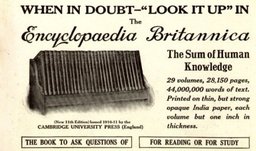|
|
EB11.jpg
The Eleventh Edition of the Encyclopædia Britannica (1911) in many ways represents the sum of knowledge at the beginning of the 20th century. The edition is still often regarded as the greatest edition of the Encyclopædia Britannica, with many articles being up to 10 times the length of those in other encyclopædias.
Some articles were written by the best-known scholars and learned gentlemen of the age, such as Edmund Gosse, J.B. Bury, Algernon Charles Swinburne, John Muir, Prince Peter Kropotkin, T.H. Huxley, William Michael Rossetti, Albert Einstein and Henry Ford, as well as many other names now less known. Many others were carried over from the Ninth Edition, some with minimal updating, some of the book-length articles divided into smaller parts for easier reference, yet others heavily abridged. Many articles are still of value and interest to modern readers and scholars. The best known authors generally contributed only a single article or part of an article, however. The majority of the work was done by a mix of journalists, British Museum staff, and academics. Among these lesser known contributors were some who would later achieve greatness such as Ernest Rutherford and Bertrand Russell.
The Eleventh Edition was a notable reorganization and rewriting of the Encyclopædia Britannica, which was first published in three volumes in 1768. The Eleventh Edition formed the basis for every edition of the Encyclopædia Britannica up until 1974, when the completely new Fifteenth Edition, based on modern information presentation, was published.
Sir Kenneth Clark, in Another Part of the Wood, wrote of the Eleventh Edition:
- One leaps from one subject to another, fascinated as much by the play of mind and the idiosyncrasies of their authors as by the facts and dates. It must be the last encyclopædia in the tradition of Diderot which assumes that information can be made memorable only when it is slightly coloured by prejudice. When T.S. Eliot wrote "Soul curled up on the window seat reading the Encyclopædia Britannica" he was certainly thinking of the eleventh edition.
The 1911 edition for the first time saw a number of female contributors. Thirty-four women contributed articles to the edition.
The 1911 edition is no longer restricted by copyright, and it is available in several more modern forms.
| Contents |
Gutenberg Encyclopedia
The Project Gutenberg Encyclopedia is actually the 1911 EB, renamed to address Britannica's trademark concerns. However, as of October 2004, Project Gutenberg only holds an electronic version of Volume 1. Distributed Proofreaders is currently working on producing a complete electronic edition of the 1911 Encyclopædia Britannica, which will be available from Project Gutenberg when finished. As of October 2004, proofed text of articles in volumes 2 – 5 is accessible via DP's Post Processing page (http://www.pgdp.net):
| Volume 2.1: | ANDROS, SIR EDMUND | — | ARGENTINA |
| Volume 2.2: | ARGENTINA | — | AUSTRIA |
| Volume 3.1: | AUSTRIA, LOWER | — | BASSOON |
| Volume 3.2: | BASSOON | — | BISECTRIX |
| Volume 4.1: | BISHÂRÎN | — | BORGIA, LUCREZIA |
| Volume 4.2: | BORDEAUX | — | BRÉQUIGNY |
| Volume 4.3: | BRÉQUIGNY | — | BULGARIA |
| Volume 4.4: | BULGARIA | — | CALGARY |
| Volume 5.1: | CALHOUN, JOHN CALDWELL | — | CAPE COLONY |
| Volume 5.2: | CAPE COLONY | — | CAT |
| Volume 5.3: | CAT | — | CERAMIC |
(Some assembly required!)
As of October 2004, unproofed text of articles in volume 5.4 (CERAMIC — CHATELAINE) is accessible via [1] (http://www.pgdp.net)
References
- All There is to Know (1994), edited by Alexander Coleman and Charles Simmons. Subtitled: "Readings from the Illustrious Eleventh Edition of the Encyclopædia Britannica". ISBN 0-671-76747-X
- Gillian Thomas (1992). A Position to Command Respect: Women and the Eleventh Britannica New Jersey: The Scarecrow Press, ISBN 0810825678.
External links
Versions can be found at:
- LoveToKnow Free Online Encyclopedia (http://1911encyclopedia.org) World Wide Web edition. This appears to be a raw, unproofread OCR-scanned version, and so contains many errors and no illustrations. A footnone says: Although linking to this site is encouraged, reproducing Contents on another site or redistributing Contents is forbidden. Taking Contents from this site and editing it and posting it on another site is forbidden and will result in swift legal action. This implies that the content is not public domain. Determining actual copyright status may require legal advice.
- Online Encyclopedia (http://encyclopedia.jrank.org/). World Wide Web, OCR-scanned version of the encyclopedia, that has scanning errors. At the bottom of a page the following footnote can be seen Site content, images, and layout Copyright © 2004 - Net Industries, worldwide. Do not copy, download, transfer, or otherwise replicate the site content in whole or in part. Links to articles and home page are always encouraged.
- ClassicEB.com (http://classiceb.com/) for a CD-ROM version. This edition has all the illustrations, including thousands of steel engravings and line drawings, but is not text-searchable, since it consists of 300dpi images only. These pages also present some information about the Eleventh and other editions of the Encyclopædia Britannica.
- www.robinsoncurriculum.com (http://www.robinsoncurriculum.com/view/rc/s31p45.htm)1911 Encyclopaedia Britannica plus 250 books, most of K-12 curriculum for home schooling, 120,000 pages, for sale on 22 CD-ROMs. All the image files of books in the product are claimed to be copyrighted, although all but a few of the books are in the public domain. Determining actual copyright status may require legal advice.
- the Project Gutenberg version (http://www.gutenberg.org/etext/13600)

